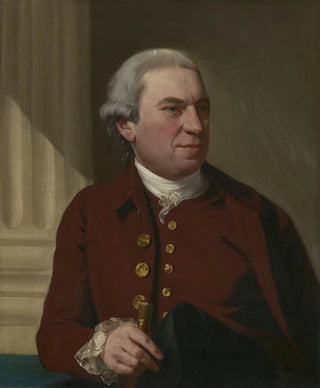Art print | Robert Hyde, écuyer de Hyde - John Singleton Copley


View from behind

Frame (optional)
Robert Hyde, squire of Hyde - John Singleton Copley – Captivating Introduction
The artwork "Robert Hyde, squire of Hyde" by John Singleton Copley stands as a vivid testament to 18th-century art, a time when painting intertwined with history and culture. This portrait, capturing the essence of a man in all his dignity, invites us to delve into a world where identity and social status are reflected through the artist's brush. Copley, with his skill, manages to immortalize not only Hyde's physical features but also his character and rank, transporting us to a bygone era where every detail matters. The art print Robert Hyde, squire of Hyde - John Singleton Copley offers an entry point into this fascinating period, where each glance at the painting evokes a story to tell.
Style and uniqueness of the work
Copley's style is distinguished by its ability to blend realism with impressive psychological depth. In this piece, every element is carefully considered, from the folds of the robe to the subtle expressions on the face. Copley uses a palette of rich, warm colors that give his subject an almost tangible presence. Light plays a crucial role in the composition, illuminating Hyde's face and creating a contrast with the dark background, which emphasizes the imposing stature of the figure. Hyde's posture, upright and confident, along with his direct gaze at the viewer, demonstrates unwavering self-assurance. This portrait is not merely a physical representation but an exploration of the human soul, an invitation to reflect on the nature of power and honor.
The artist and his influence
John Singleton Copley, born in Boston in 1738, is considered one of the greatest portraitists of his time. His career, marked by a transition to Europe, was influenced by European artistic currents while maintaining an American essence. Copley captured the spirit of his era, establishing himself as a witness to the sociopolitical changes that shaped emerging America. His work not only influenced his contemporaries but continues to inspire generations of artists. Combining impeccable technique with a

Matte finish

View from behind

Frame (optional)
Robert Hyde, squire of Hyde - John Singleton Copley – Captivating Introduction
The artwork "Robert Hyde, squire of Hyde" by John Singleton Copley stands as a vivid testament to 18th-century art, a time when painting intertwined with history and culture. This portrait, capturing the essence of a man in all his dignity, invites us to delve into a world where identity and social status are reflected through the artist's brush. Copley, with his skill, manages to immortalize not only Hyde's physical features but also his character and rank, transporting us to a bygone era where every detail matters. The art print Robert Hyde, squire of Hyde - John Singleton Copley offers an entry point into this fascinating period, where each glance at the painting evokes a story to tell.
Style and uniqueness of the work
Copley's style is distinguished by its ability to blend realism with impressive psychological depth. In this piece, every element is carefully considered, from the folds of the robe to the subtle expressions on the face. Copley uses a palette of rich, warm colors that give his subject an almost tangible presence. Light plays a crucial role in the composition, illuminating Hyde's face and creating a contrast with the dark background, which emphasizes the imposing stature of the figure. Hyde's posture, upright and confident, along with his direct gaze at the viewer, demonstrates unwavering self-assurance. This portrait is not merely a physical representation but an exploration of the human soul, an invitation to reflect on the nature of power and honor.
The artist and his influence
John Singleton Copley, born in Boston in 1738, is considered one of the greatest portraitists of his time. His career, marked by a transition to Europe, was influenced by European artistic currents while maintaining an American essence. Copley captured the spirit of his era, establishing himself as a witness to the sociopolitical changes that shaped emerging America. His work not only influenced his contemporaries but continues to inspire generations of artists. Combining impeccable technique with a






